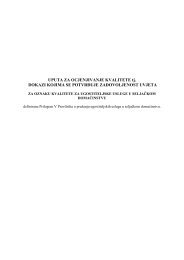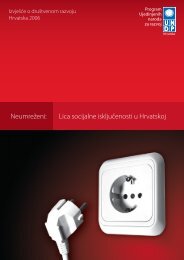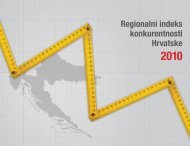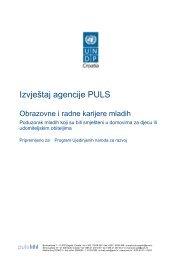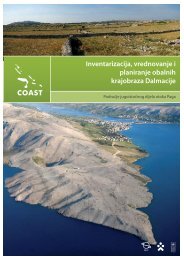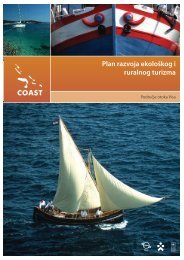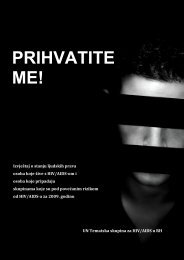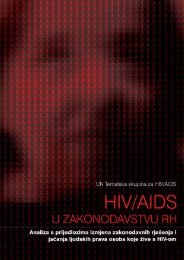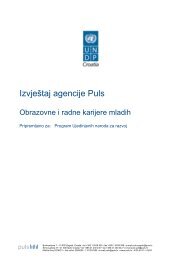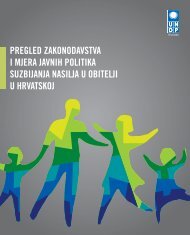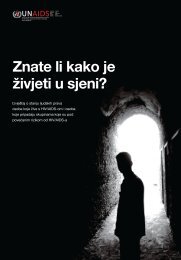WEB engleska verzija end.indd - UNDP Croatia
WEB engleska verzija end.indd - UNDP Croatia
WEB engleska verzija end.indd - UNDP Croatia
- No tags were found...
Create successful ePaper yourself
Turn your PDF publications into a flip-book with our unique Google optimized e-Paper software.
CHAPTER 3THE SOCIALLY EXCLUDED462001, only 3% of the Roma from the national surveysample were over 60 years of age. This is attributed toextremely poor living conditions, such as below-averagehousing, lack of basic infrastructure, unvaried andmodest nutrition, and constant insecurity. In addition,the percentage of Roma women in the total Romapopulation is lower than the percentage of men. 60However, the Roma associations have noted somepositive indications; they estimate that the numberof Roma women giving birth in hospital is on the rise,as well as the number of inoculated pre-schoolers.Most members of the Serb minority have access tobasic health insurance. A large number of Serb returneesto <strong>Croatia</strong> are elderly people who have theright to a pension, acquired before the war, as well astheir entitlement to health insurance. Others exercisethe right to insurance through a family member orthrough unemployment insurance (after brief, frequentlyfictitious employment in <strong>Croatia</strong>). There areonly sporadic examples of serious problems in accessto health insurance (for example, returnee childrenwho study in BiH or Serbia).However, physical access to health protection representsa serious problem. Considering that manyreturnees live in sparsely inhabited areas with littleor no transport infrastructure, access to even primaryhealth protection is a problem. In some cases wholemunicipalities (like Vrhovine, for example) do nothave offices for family medicine. Travelling to see adoctor is thus connected with substantial costs for thealready disadvantaged population, and access to theservices of specialised medicine is even more limited.It should be said that health insurance does not coverthe cost of travel to the doctor at distances under 50km, and in areas where the Serb returnee populationreside, travel by public transport at distances under50 km is relatively expensive.3.2.4 Access to EducationDespite a number of proposals concerning systematicchanges that would enable individualised education,changes in educational institutions have been slowand sporadic. Numerous Roma non-governmentalassociations, as well as the National Programme forthe Roma, state that pre-school education is criticalin preparation for primary school education andlowers drop-out rates. Since pre-school education is60 Ibid.decentralised (funded from the county budget), thenetwork of services and their availability is unequaland the capacity for accommodating children is alsolimited. Roma associations have developed a seriesof compensatory models for pre-school educationincluding half-day play schools within Roma settlementsand programmes on premises outside Romasettlements. These programmes would featurelimited contact with non-Roma children, and anemphasis on the <strong>Croatia</strong>n language and social skills,but also more vocal initiatives to enrol Roma childreninto the existing kindergartens leading to completeintegration. Despite differences in the organisationalperformance of these models, as well as the methodsof work, which greatly dep<strong>end</strong> on the readiness ofthe institutions to provide modified and intensifiedservices to specific segments of the population, mostimplementing bodies agree that it is necessary toregularly att<strong>end</strong> such programmes for at least twoyears prior to primary school.There is no precise data on the number or g<strong>end</strong>er ofRoma children entering the mandatory primary educationalsystem or complete data regarding drop outrates. According to the report entitled Faces of Poverty,Faces of Hope (<strong>UNDP</strong>, 2005), 17% of the Roma and74% of the non-Roma population over 12 years of agewho live in the vicinity of the Roma population, havefinished primary school. This ranks <strong>Croatia</strong>, togetherwith Serbia, somewhere between the Czech Republicand Hungary, who have the highest percentage ofthe Roma over 12 with a complete primary schooleducation, and Kosovo and Montenegro where thepercentage is the lowest.Having guaranteed entry into the school systemdoes not necessarily mean that Roma will remain inthe system and that they will be able to take full advantageof the opportunity. A combination of severalfactors creates a “push out effect” in what is alreadya very small number of the Roma who enter theschool system. These factors relate to: a lower level ofpreparedness to meet the demands placed on Romachildren in school as opposed to non-Roma children;organisation of school work that presumes students’conformity; and the diminished readiness of teachersto introduce individualised methods of teaching.There are also factors within the Roma communityitself which “pull away” children from the educationalsystem related to a lack of confidence in the system,loss of income as children participate, a lack of incen-



